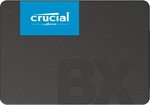Crucial BX500 1TB 2.5" SSD, CT1000BX500SSD1, Black down to $69/85 which appears to be the lowest on Amazon accoridng to CamelCamelCamel.
Prices continue to drop on SSDs which is great to see.
About this item
- Boot up faster. Load files quicker. Improve overall system responsiveness
- 300% faster than a typical Hard drive
- Improves battery life because it's 45x more energy efficient than a typical Hard drive
- Micron 3D NAND – advancing the world's Memory and storage technology for 40 years



 CamelCamelCamel
CamelCamelCamel

absolute junk speeds don't bother